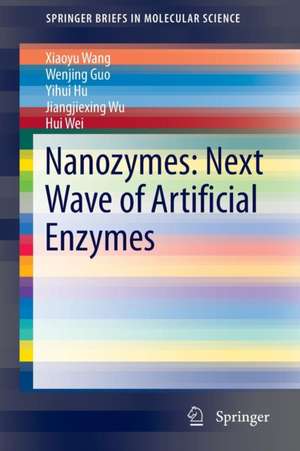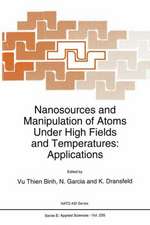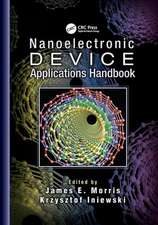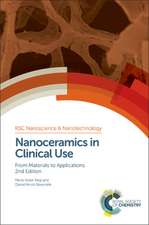Nanozymes: Next Wave of Artificial Enzymes: SpringerBriefs in Molecular Science
Autor Xiaoyu Wang, Wenjing Guo, Yihui Hu, Jiangjiexing Wu, Hui Weien Limba Engleză Paperback – 8 aug 2016
Din seria SpringerBriefs in Molecular Science
-
 Preț: 411.46 lei
Preț: 411.46 lei -
 Preț: 379.09 lei
Preț: 379.09 lei -
 Preț: 356.49 lei
Preț: 356.49 lei -
 Preț: 441.25 lei
Preț: 441.25 lei -
 Preț: 389.70 lei
Preț: 389.70 lei -
 Preț: 376.22 lei
Preț: 376.22 lei -
 Preț: 348.77 lei
Preț: 348.77 lei -
 Preț: 345.14 lei
Preț: 345.14 lei -
 Preț: 347.68 lei
Preț: 347.68 lei -
 Preț: 346.70 lei
Preț: 346.70 lei -
 Preț: 376.43 lei
Preț: 376.43 lei -
 Preț: 342.14 lei
Preț: 342.14 lei -
 Preț: 375.23 lei
Preț: 375.23 lei -
 Preț: 375.23 lei
Preț: 375.23 lei -
 Preț: 379.09 lei
Preț: 379.09 lei -
 Preț: 376.59 lei
Preț: 376.59 lei -
 Preț: 476.79 lei
Preț: 476.79 lei -
 Preț: 378.12 lei
Preț: 378.12 lei -
 Preț: 376.59 lei
Preț: 376.59 lei -
 Preț: 376.59 lei
Preț: 376.59 lei -
 Preț: 375.23 lei
Preț: 375.23 lei -
 Preț: 351.18 lei
Preț: 351.18 lei -
 Preț: 377.73 lei
Preț: 377.73 lei -
 Preț: 372.73 lei
Preț: 372.73 lei -
 Preț: 378.54 lei
Preț: 378.54 lei -
 Preț: 376.96 lei
Preț: 376.96 lei -
 Preț: 377.35 lei
Preț: 377.35 lei -
 Preț: 378.12 lei
Preț: 378.12 lei -
 Preț: 376.04 lei
Preț: 376.04 lei -
 Preț: 346.59 lei
Preț: 346.59 lei -
 Preț: 375.45 lei
Preț: 375.45 lei -
 Preț: 377.73 lei
Preț: 377.73 lei -
 Preț: 381.00 lei
Preț: 381.00 lei -
 Preț: 377.18 lei
Preț: 377.18 lei -
 Preț: 376.96 lei
Preț: 376.96 lei -
 Preț: 380.07 lei
Preț: 380.07 lei -
 Preț: 376.22 lei
Preț: 376.22 lei -
 Preț: 343.72 lei
Preț: 343.72 lei -
 Preț: 376.22 lei
Preț: 376.22 lei -
 Preț: 377.35 lei
Preț: 377.35 lei -
 Preț: 343.72 lei
Preț: 343.72 lei -
 Preț: 376.22 lei
Preț: 376.22 lei -
 Preț: 375.07 lei
Preț: 375.07 lei -
 Preț: 374.85 lei
Preț: 374.85 lei - 15%
 Preț: 464.97 lei
Preț: 464.97 lei -
 Preț: 376.43 lei
Preț: 376.43 lei -
 Preț: 341.75 lei
Preț: 341.75 lei -
 Preț: 374.30 lei
Preț: 374.30 lei -
 Preț: 375.23 lei
Preț: 375.23 lei -
 Preț: 377.57 lei
Preț: 377.57 lei
Preț: 412.30 lei
Nou
Puncte Express: 618
Preț estimativ în valută:
78.90€ • 81.88$ • 65.95£
78.90€ • 81.88$ • 65.95£
Carte tipărită la comandă
Livrare economică 17-31 martie
Preluare comenzi: 021 569.72.76
Specificații
ISBN-13: 9783662530665
ISBN-10: 366253066X
Pagini: 123
Ilustrații: X, 127 p. 56 illus., 47 illus. in color.
Dimensiuni: 155 x 235 x 8 mm
Greutate: 0.2 kg
Ediția:1st ed. 2016
Editura: Springer Berlin, Heidelberg
Colecția Springer
Seria SpringerBriefs in Molecular Science
Locul publicării:Berlin, Heidelberg, Germany
ISBN-10: 366253066X
Pagini: 123
Ilustrații: X, 127 p. 56 illus., 47 illus. in color.
Dimensiuni: 155 x 235 x 8 mm
Greutate: 0.2 kg
Ediția:1st ed. 2016
Editura: Springer Berlin, Heidelberg
Colecția Springer
Seria SpringerBriefs in Molecular Science
Locul publicării:Berlin, Heidelberg, Germany
Cuprins
Introduction to nanozymes.- Carbon-based nanomaterials for nanozymes.- Metal-based nanomaterials for nanozymes.- Metal oxide-based nanomaterials for nanozymes.- Other nanomaterials for nanozymes.-Challenges and perspectives.
Notă biografică
Xiaoyu Wang is a graduate student at the Department of Biomedical Engineering, College of Engineering and Applied Sciences, Nanjing University. He received his B.S. degree from Nanjing Institute of Technology in 2014. In the same year he joined Professor Hui Wei's group. His research interests focus on nanozymes for biomedical and bioanalytical applications.
Wenjing Guo is a graduate student at the Department of Biomedical Engineering, College of Engineering and Applied Sciences, Nanjing University. She received her B.S. degree from Nanjing University in 2014. In the same year she joined Professor Hui Wei's group. Her research interests focus on nanozymes for biomedical and bioanalytical applications.
Yihui Hu is a graduate student at the Department of Biomedical Engineering, College of Engineering and Applied Sciences, Nanjing University. She received her B.S. degree from Hengyang Normal University in 2010 and her Master degree from Hunan University in 2013. In 2014, she joined Professor Hui Wei's group. Her research interests focus on bioanalytical and biomedical chemistry. Jiangjiexing Wu is a research associate professor at the Department of Biomedical Engineering, College of Engineering and Applied Sciences, Nanjing University. She received her B.S. degree and Ph.D. from Tianjin University in 2009 and 2014, respectively. In 2016, she joined Professor Hui Wei's group. Her research interests focus on DNA-directed approach to fabricate functional nanomaterials.
Hui Wei is a professor at the Department of Biomedical Engineering, College of Engineering and Applied Sciences, Nanjing University, China. He joined Nanjing University after his postdoctoral training with Professors Yi Lu and Shuming Nie, respectively. He received his B.S. from Nanjing University in 2003, where he carried out his undergraduate research with Professor Xinghua Xia. In the same year he joined Professor Erkang Wang’s group at Changchun Institute of Applied Chemistry, Chinese Academy of Sciences, and received his Ph.D. in 2008. He has been admitted as a Fellow of Royal Society of Chemistry (FRSC). His research interests focus on functional bionanomaterials (including nanozymes), in vivo bioanalysis, in vitro diagnostics and precision medicine.
Wenjing Guo is a graduate student at the Department of Biomedical Engineering, College of Engineering and Applied Sciences, Nanjing University. She received her B.S. degree from Nanjing University in 2014. In the same year she joined Professor Hui Wei's group. Her research interests focus on nanozymes for biomedical and bioanalytical applications.
Yihui Hu is a graduate student at the Department of Biomedical Engineering, College of Engineering and Applied Sciences, Nanjing University. She received her B.S. degree from Hengyang Normal University in 2010 and her Master degree from Hunan University in 2013. In 2014, she joined Professor Hui Wei's group. Her research interests focus on bioanalytical and biomedical chemistry. Jiangjiexing Wu is a research associate professor at the Department of Biomedical Engineering, College of Engineering and Applied Sciences, Nanjing University. She received her B.S. degree and Ph.D. from Tianjin University in 2009 and 2014, respectively. In 2016, she joined Professor Hui Wei's group. Her research interests focus on DNA-directed approach to fabricate functional nanomaterials.
Hui Wei is a professor at the Department of Biomedical Engineering, College of Engineering and Applied Sciences, Nanjing University, China. He joined Nanjing University after his postdoctoral training with Professors Yi Lu and Shuming Nie, respectively. He received his B.S. from Nanjing University in 2003, where he carried out his undergraduate research with Professor Xinghua Xia. In the same year he joined Professor Erkang Wang’s group at Changchun Institute of Applied Chemistry, Chinese Academy of Sciences, and received his Ph.D. in 2008. He has been admitted as a Fellow of Royal Society of Chemistry (FRSC). His research interests focus on functional bionanomaterials (including nanozymes), in vivo bioanalysis, in vitro diagnostics and precision medicine.
Textul de pe ultima copertă
This book describes the fundamental concepts, the latest developments and the outlook of the field of nanozymes (i.e., the catalytic nanomaterials with enzymatic characteristics). As one of today’s most exciting fields, nanozyme research lies at the interface of chemistry, biology, materials science and nanotechnology. Each of the book’s six chapters explores advances in nanozymes. Following an introduction to the rise of nanozymes research in the course of research on natural enzymes and artificial enzymes in Chapter 1, Chapters 2 through 5 discuss different nanomaterials used to mimic various natural enzymes, from carbon-based and metal-based nanomaterials to metal oxide-based nanomaterials and other nanomaterials. In each of these chapters, the nanomaterials’ enzyme mimetic activities, catalytic mechanisms and key applications are covered. In closing, Chapter 6 addresses the current challenges and outlines further directions for nanozymes. Presenting extensive information on nanozymes and supplemented with a wealth of color illustrations and tables, the book offers an ideal guide for readers from disparate areas, including analytical chemistry, materials science, nanoscience and nanotechnology, biomedical and clinical engineering, environmental science and engineering, green chemistry, and novel catalysis.
Caracteristici
Provides a broad portrait of nanozymes in the context of artificial enzyme research Covers various nanomaterials with enzyme mimicking properties, from carbon-based and metal-based nanomaterials to metal oxide-based nanomaterials and other nanomaterials Introduces various applications of nanozymes, from biosensing and cancer diagnostics to tissue engineering and therapeutics Discusses the current challenges and further directions of nanozymes Incudes a wealth of color illustrations and tables Includes supplementary material: sn.pub/extras


















